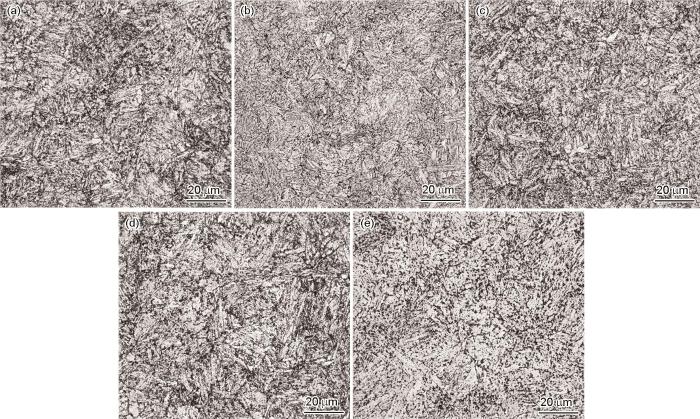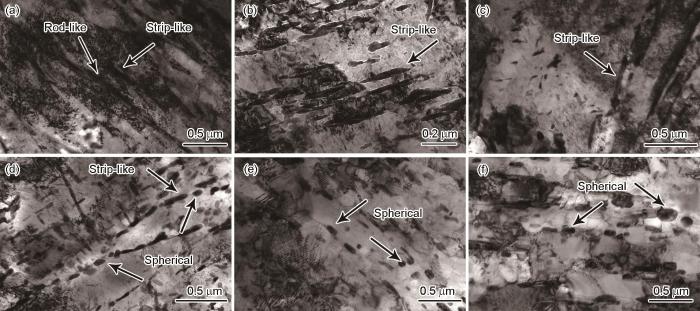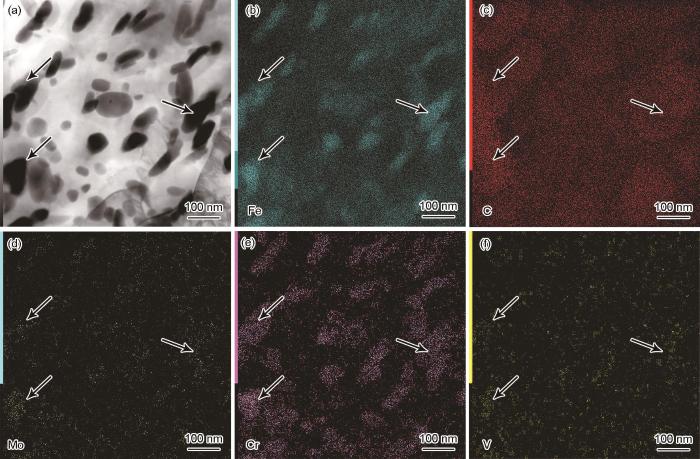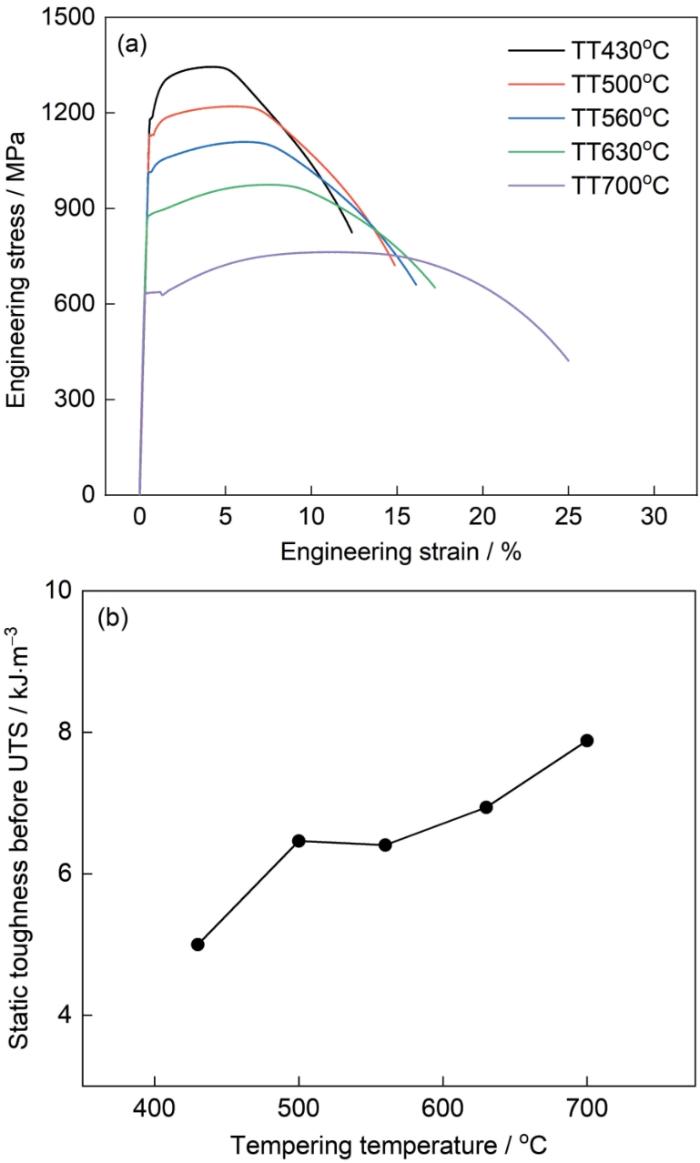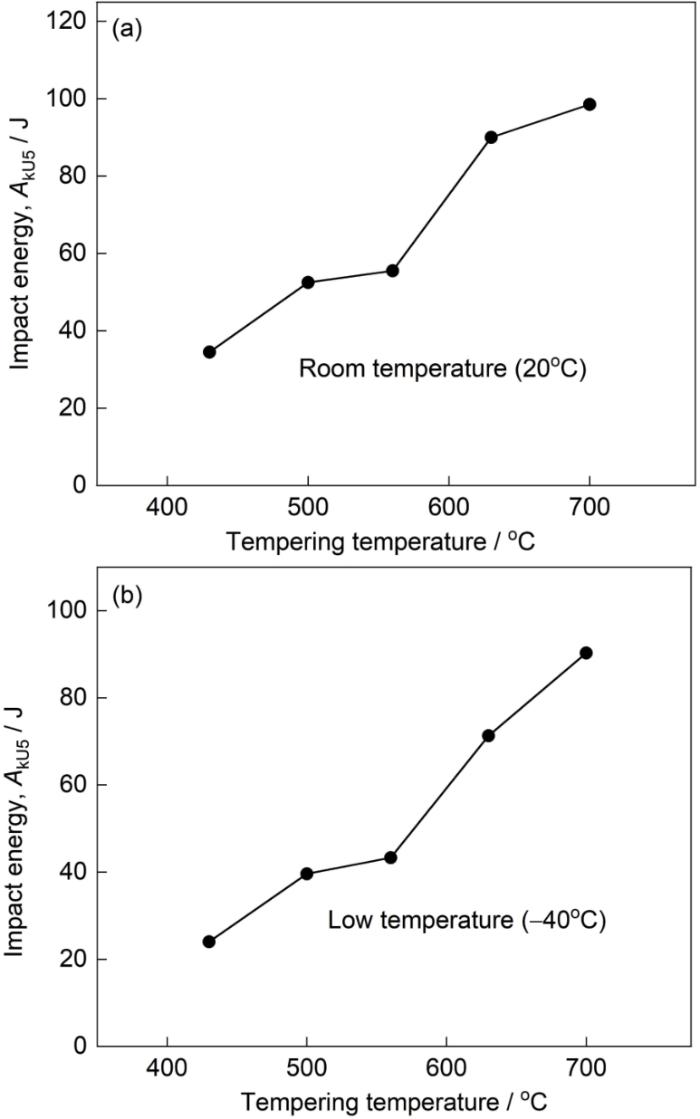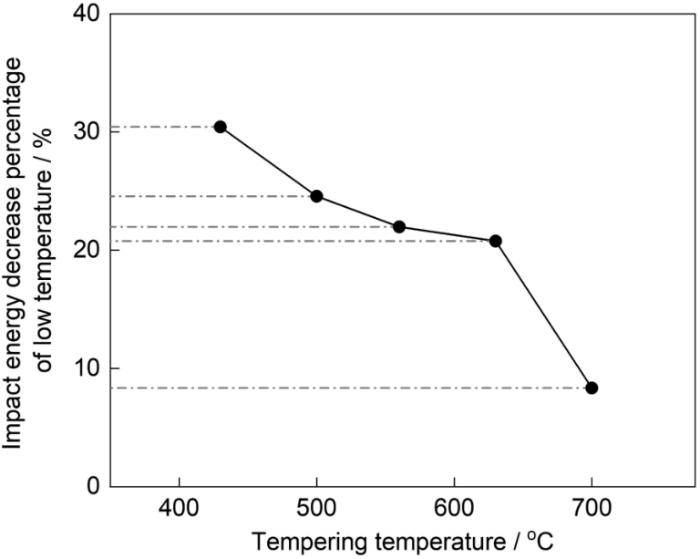铁路列车的车轴是支撑车体和传递动力的重要部件,一旦失效将引起严重事故[1,2]。在颠簸和紧急制动等特殊情况下列车的车轴承受极大的冲击载荷,极易发生意外断裂[3]。随着我国高速列车的发展,极需充分考虑严苛服役情况下的行车安全和稳定性。我国南北地域的温差较大,因此对车轴用钢的低温韧性要求极高。金属材料在低温下易发生韧-脆转变而使其断裂失效,20世纪发生的许多重大灾难性事故便与此相关。低温脆性,是泰坦尼克号船体断裂使其沉没的重要原因。造船工程师为了提高材料的强度使用含硫量很高的钢材制造船体,其在低温下的脆性是服役安全的隐患。因此,对于在低温下服役的车轴钢,表征其低温冲击性能和抗低温断裂以指导其生产,保障其在低温下安全服役至关重要[4]。
由于强韧性关系倒置,在提高材料低温冲击韧性的同时,还须使其具有较高的强度[5,6]。首先,需要认识韧-脆转变行为以解释低温脆性的本质。韧性材料具有优异的塑性变形能力,能承受很大的应变,因此在失效前能吸收比脆性材料更多的形变能。金属从韧性断裂行为转变为脆性断裂行为的临界温度,称为韧-脆转变温度(DBTT)[7]。在温度低于DBTT时材料不发生塑性变形,且裂纹扩展速率迅速提高使其发生脆性破坏。韧-脆转变,与材料的晶体结构密切相关。面心立方金属(fcc)通常不发生低温脆化转变,而体心立方金属(bcc)有明显的韧-脆转变行为。其原因是,bcc金属的塑性变形主要决定于螺位错行为,而其特殊的螺位错三维核心结构需要热激活产生滑移[8,9]。因此,低温脆性的本质与位错在晶体中运动的阻力有关。温度降低使位错运动的阻力增大和原子热激活能力下降,位错堆积在硬碳化物相附近使裂纹扩展更快进而发生脆性断裂[10,11]。低温脆性,与材料的成分组成、微观组织以及晶粒尺寸等因素有关。双相钢的低温脆性与大尺寸铁素体的解理断裂有关[12],可通过合金设计控制片层在双相区的稳定性加以改善[13]。根据Cottrell理论和Hall-Petch关系,可推导出材料的韧脆转变温度与其平均晶粒尺寸的关系[14]。减小材料的平均晶粒尺寸,有利于降低韧脆转变温度从而提高其低温冲击功。
中国是高速铁路商业运行速度最高的国家,“复兴号”列车使用具有完全自主知识产权的高速车轴列车车轴材料DZ2钢,能保证在350 km/h速度下的稳定安全服役[15]。国内高铁行业遵守标准型技术文件TJ/CL 520-2016《动车组用DZ2钢车轴暂行技术条件》,对DZ2钢车轴钢的性能和检验规则等提出了要求,作为理论规范用于指导车轴的设计、生产和检验。已有学者研究了材料的热处理工艺对其力学性能的影响。结果表明,随着淬火温度的提高塑性变化不明显,但是回火热处理对其性能特别是韧性的影响较大[16,17]。其原因是,回火热处理直接影响高速列车车轴钢材料DZ2钢中的位错密度和碳化物的析出,进而使其强度降低和延伸率和韧性提高。对EA4T在低温下韧性的研究表明,韧-脆转变温度普遍低于服役温度区,与成分热处理工艺等因素密切相关[18,19]。
影响材料低温脆性的不同因素对其组织和形貌的影响不同,之前的研究没有综合分析车轴钢DZ2钢的低温脆性。高速列车车轴钢在低温环境下的冲击韧性对温度极为敏感,因此根据对性能的要求并结合对动车组列车车轴钢EA4T的低温性能研究结果,平衡合适的强韧性匹配,分析在特定热处理条件下车轴钢DZ2钢组织中碳化物和基体组织的耦合,从而知道怎样的回火热处理工艺对低温脆性的影响最小。基于以上分析,本文调整DZ2钢车轴钢的热处理回火温度,研究其强韧性关系和低温脆性。
1 实验方法
实验用材料是高速列车车轴材料DZ2钢钢坯料,根据TJ/CL 520-2016《动车组用DZ2钢车轴暂行技术条件》,其化学成分如表1所示。
表1 高速列车车轴钢DZ2钢的化学成分
Table 1
| C | Si | Mn | P | S | Cr | Ni | Mo | V | Al | Cu | |
|---|---|---|---|---|---|---|---|---|---|---|---|
| 0.24~0.32 | 0.20~0.40 | 0.60~0.80 | ≤ 0.010 | ≤ 0.010 | 0.90~1.20 | 0.50~1.50 | 0.20~0.30 | ≤ 0.06 | 0.010~0.040 | ≤ 0.20 |
为了探究回火温度对高速列车车轴钢DZ2钢性能的影响,将坯料锻造成直径为20 mm的棒料,然后进行正火+淬火+回火的热处理,正火温度为920℃,淬火温度为890℃,回火温度分别为430、500、560、630、700℃,保温1.5 h后空冷到室温。
用电火花线切割机将热处理后的棒料切割成标距段直径为4 mm的标准拉伸试样,5 mm U型缺口的冲击试样,其长度方向垂直于车轴轴向。根据GB/T 228. 1-2010《金属材料 拉伸试验 第1部分:室温试验方法》,在Instron 5982拉伸机上进行单轴拉伸试验,初始应变速率为10-3 s-1,每组有四个试样,取其结果的平均值。拉伸试验在室温空气中进行,用引伸计测量应变。按照GB/T 229-2007《金属材料 夏比摆锤冲击试验方法》标准分别在室温(20℃)和低温(-40℃)下进行夏比摆锤冲击功试验,每组检测三个试样,取其结果的平均值。
为了分析回火对试验钢的组织及析出物的影响,将分别在430、500、560、630、700℃回火的试样研磨、抛光,用4%硝酸酒精浸蚀后在光学显微镜下观察微观组织。分别从回火后的试样上切取透射电子显微镜(TEM)样品,将其研磨后进行双喷电解减薄,电解液为10%的高氯酸酒精溶液。双喷电压为20 V,温度为-20℃。用TEM观察样品的微观组织和碳化物分布。
2 结果和讨论
2.1 回火温度对DZ2钢样品微观组织的影响
图1
图1
DZ2钢在不同温度回火后的金相组织
Fig.1
Metallographic structure of DZ2 steel tempering at different tempering temperatures (a) 430oC; (b) 500oC; (c) 560oC; (d) 630oC; (e) 700oC
回火影响碳化物的析出行为,进而影响材料的断裂性能[22,23]。回火温度为430、500、560、630、700℃的五组试样,其透射电镜照片如图2所示。由图2可见,在不同温度回火的实验钢中都出现了大量的碳化物,对于碳化物的平均尺寸(图3a)、平均间距(图3b)和平均长宽比(图3c)的统计结果表明,随着回火温度的提高碳化物的平均尺寸和平均间距变化不大,碳化物的平均间距与其数量呈反相关关系[24,25],因此可用碳化物的平均尺寸与平均间距倒数的积(即平均尺寸/平均间距)表征出碳化物的平均析出量(图3d)。计算结果表明,在不同温度回火后碳化物的析出量基本上是同一数量级。而在形貌上碳化物的长宽比减小,结合图2可见碳化物的形状由棒状(长宽比> 12)和条带状(3 <长宽比< 12)变为球状(Spherical,长宽比< 3)。棒状和条带状碳化物主要分布在原马氏体板条界面,而球状碳化物的分布较为均匀。
图2
图2
DZ2钢在不同温度回火后的显微组织TEM像和碳化物形貌
Fig.2
TEM images of microstructure and carbide morphology of DZ2 steel after tempering at different tempering temperatures (a) 430oC; (b) 500oC; (c) 560oC; (d) 630oC; (e, f) 700oC
图3
图3
DZ2钢材料在不同温度回火后组织中碳化物的相关参数与回火温度的关系
Fig.3
Relationship between carbide related parameters and tempering temperature in the microstructure of DZ2 steel after tempering at different tempering temperatures: (a) average size of carbide; (b) average spacing of carbides; (c) average aspect ratio of carbides; (d) the ratio of average size to average spacing
图4
图4
DZ2钢在630℃回火后的透射电镜显微组织照片和 EDS面扫描照片
Fig.4
TEM microstructure of DZ2 steel after tempering at 630oC (a) and EDS surface scanning results (b) Fe; (c) C; (d) Mo; (e) Cr; (f) V
2.2 回火温度对DZ2钢试样力学性能的影响
在不同温度回火的DZ2钢,其拉伸和常低温试验结果列于表2。可以看出,随着回火温度的提高拉伸强度逐渐下降、延伸率提高。图5a给出了在不同温度回火后试样的工程应力-应变曲线。可以看出,在430℃回火的试样其极限抗拉强度最高(为1372 MPa),但是变形能力较差(断后延伸率仅11.7%);在700℃回火的试样其极限抗拉强度最低(为769 MPa),断后延伸率为28.4%。静力韧度是金属材料在静拉伸时单位体积材料断裂前吸收的功,等于应力-应变曲线下的面积;而材料发生颈缩后只在颈缩处形变,因此统计了颈缩前的静力韧度。图5b给出了颈缩前静力韧度与回火温度的关系。可以看出,随着回火温度的提高颈缩前的静力韧度提高,表征试样的均匀变形能力较好。
表2 在不同温度回火后样品的拉伸性能和冲击性能
Table 2
| Tempering temperature | 430oC | 500oC | 560oC | 630oC | 700oC |
|---|---|---|---|---|---|
| Ultimate tensile strength (UTS) / MPa | 1357 | 1224 | 1120 | 898 | 761 |
| Fracture elongation / % | 11.7 | 14.0 | 17.0 | 20.7 | 28.4 |
| Room temperature impact energy / J | 34.3 | 52.3 | 55.7 | 90 | 98.7 |
| Low temperature impact energy / J | 24 | 39.7 | 43.3 | 71.3 | 90.3 |
图5
图5
DZ2钢在不同温度回火后的拉伸性能和静力韧度统计结果
Fig.5
Tensile test results of DZ2 steel after tempering at different tempering temperatures (TT) (a) engineering stress-strain curve; (b) the statistical results of static toughness before UTS vary with the tempering temperature
随着回火温度的提高,位错强化、沉淀强化和固溶强化都影响材料的强度[29]。首先,马氏体的分解和位错密度的降低使位错强化的效果减弱。其次,钢中的碳原子与铁或其他合金原子结合生成合金渗碳体,碳化物的增多使试样的沉淀强化效果提高。而在此过程中固溶的碳原子减少,使固溶强化效果显著降低。拉伸试验的数据表明,随着回火温度的提高试样的抗拉强度越来越低。这表明,位错强化和固溶强化的降低明显高于沉淀强化的提高。
图6
图6
DZ2钢在不同温度回火后的冲击功与回火温度的关系
Fig.6
Relationship between impact energy and tempering temperature (a) 20oC room temperature impact energy; (b) -40oC low temperature impact energy
钢的微观组织的变化,导致局部应力-应变行为的不规则性[31]。在较低温度下回火,长宽比较大的碳化物使冲击裂纹扩展区的裂纹更容易沿碳化物的长轴方向扩展。在较高温区回火后更多更均匀的球状碳化物使裂纹扩展没有固定的方向,即裂纹的扩展路径更为曲折,消耗的形变断裂能量更多。同时,在不同温度回火后的试样虽然其冲击功都比在常温回火的试样低,但是降低的幅度不同。低温冲击功比常温冲击功下降的比例,表征对此试样低温脆性影响的程度,将此比例系数定义为在此温度回火试样的低温冲击功下降率
其中Ak, r和Ak, l分别为试样的常温冲击功平均值和低温冲击功平均值。图7给出了dT的计算结果与回火温度的关系。可以看出,随着回火温度的提高dT随之降低,在700℃回火的试样其冲击功下降率最低(仅为8%)。
图7
图7
低温冲击功下降率与回火温度的关系
Fig.7
Relationship between the impact energy decrease percentage of low-temperature and tempering temperature
这一结果表明,在更低的温度回火的试样其低温脆性更显著。碳化物的硬度、模量和形变抵抗能力,与材料基体不同[32]。在冲击裂纹的扩展阶段,试样内的碳化物与基体之间产生位错塞积应变集中,较硬的碳化物经历突然的塑性不稳定时不能将高速载荷的增加转移到相邻的晶粒,更容易产生解理裂纹。在较低温度回火的试样中,碳化物的长宽比较高和分布在板条界面,裂纹扩展路径必须绕过硬相碳化物。因此,更长的扩展路径使试样的冲击功的温度敏感性更高。而在较高温度回火的试样,其裂纹扩展路径受碳化物的影响较小,对其在低温条件下冲击功的影响不大。这意味着,在较高温度回火的试样中均匀分布的、球化程度更高的碳化物更有利于抗低温脆性。
3 结论
(1) 调整DZ2车轴钢热处理的回火温度,可使其组织和强度不同。随着回火温度的提高DZ2车轴钢的抗拉强度降低和延伸率提高,常温和低温冲击功也有所提高。但是,回火温度过高使低温脆性导致的冲击功下降率更小,主要决定于碳化物球化程度的提高。
(2) 高速列车DZ2车轴钢的强韧性的倒置关系显著,因此在满足力学性能标准要求的情况下,应该控制回火温度(630℃左右)使其强度较高和碳化物的球化程度较高,以降低低温脆性对冲击韧性的影响。
参考文献
The analysis and prevention of failure in railway axles
[J].
Safe life and damage tolerance aspects of railway axles-A review
[J].
Wheel-rail impact loads and axle bending stress simulated for generic distributions and shapes of discrete wheel tread damage
[J].
EA4T railway axle steel fatigue behavior under very high-frequency fatigue loading
[J].
Strength-toughness improvement of martensite-austenite dual phase deposited metals after austenite reversed treatment with short holding time
[J].
Effect of impact toughness anisotropy on brittle fracture resistance characteristics of high-strength steels subjected to thermomechanical treatment
[J].
Overview of processing, microstructure and mechanical properties of ultrafine grained bcc ste-els
[J].
Correlation between critical temperature and strength of small-scale bcc pillars
[J].
Bond-order potential for simulations of extended defects in tungsten
[J].
Low-temperature embrittlement and fracture of metals with different crystal lattices-Dislocation mechanisms
[J].
Low-temperature failure mechanism of [001] niobium micropillars under uniaxial tension
[J].
Effect of martensite morphology and volume fraction on the low-temperature impact toughness of dual-phase steels
[J].
Ultrahigh charpy impact toughness (~450J) achieved in high strength ferrite/martensite laminated steels
[J].
Ductile-brittle transition temperature of ultrafine ferrite/cementite microstructure in a low carbon steel controlled by effective grain size
[J].
High cycle fatigue properties of high speed axle materials at low temperature
[J].
高速列车车轴材料的低温高周疲劳性能
[J].
Effect of quenching temperature on microstructure and properties of high-speed axle steel
[J].
淬火温度对高铁车轴用钢组织及性能的影响
[J].利用扫描电镜(SEM)和透射电镜(TEM)研究了淬火温度对高铁车轴用钢显微组织和力学性能的影响。结果表明:随着淬火温度的升高,抗拉强度和规定塑性延伸强度先快速增大后缓慢减小,塑性变化不明显,冲击吸收能量持续下降,同时试验钢原始奥氏体晶粒长大,马氏体板条束(Packet)长大,淬火温度升高到900℃后晶粒迅速粗化,后续回火碳化物有所细化。在淬火温度为850℃时(675℃回火)试验钢具有最佳的综合性能:抗拉强度为796 MPa,规定塑性延伸强度为677 MPa,伸长率为24.5%,25℃和-40℃的冲击吸收能量(A<sub>KU<sub>2</sub></sub>,5 mm缺口)分别为82 J和72 J。
Effect of tempering process on microstructure and mechanical properties of DZ2 axle steel for high speed train
[J].
回火工艺对高速列车用DZ2车轴钢组织及力学性能的影响
[J].
Low temperature toughness of high speed and over loaded trains axle steel EA4T
[J].
高速重载列车车轴用钢EA4T的低温韧度
[J].
Research on low temperature performance of high speed EA4T axle steel
[J].
高速EA4T车轴钢低温性能研究
[J].
Tailoring the strength and ductility of T91 steel by partial tempering treatment
[J].T91 ferritic/martensitic steel (modified 9Cr-1 Mo steel) with high strength and high ductility is considered one of the promising structural materials for various industrial applications. Recent studies show that equal channel angular pressing can improve the yield strength of 191 steel to 1.6 GPa but degrade the uniform elongation to similar to 1%. Here, we report that by using a modified quenching and tempering treatment, 191 steel can achieve a high yield strength of 1.4 GPa and a uniform elongation of similar to 5.5%. Extensive microstructure analyses show the formation of transition carbides and ultra-fine martensite within bainite grains. This study provides an alternative approach to obtain a combined enhancement of strength and ductility for 191 steel. (C) 2019 Acta Materialia Inc. Published by Elsevier Ltd.
Influence of tempering temperature on stability of carbide phases in 2.6Cr-0.7Mo-0.3V steel with various carbon content
[J].
Effect of precipitation-induced element partitioning during tempering on mechanical properties of hot-rolled 3Mn steel after intercritical annealing
[J].
Microstructural evolution during tempering of an ausformed carbide-free low temperature bainitic steel
[J].
Influence of hard phase size and spacing on the fatigue crack propagation in tool steels—Numerical simulation and experimental validation
[J].
Precipitation of multiple carbides in martensitic CrMoV steels-experimental analysis and exploration of alloying strategy through thermodynamic calculations
[J].
Low temperature stress relief and martensitic decomposition in selective laser melting produced Ti6Al4V
[J].
Influence of tempering temperature and time on the α'-Ti-6Al-4V martensite
[J].
Tailoring cementite precipitation and mechanical properties of quenched and tempered steel by nickel partitioning between cementite and ferrite
[J].
Foreign object damage tolerance and fatigue analysis of induction hardened S38C axles
[J].
Strain localization and crack formation effects on stress-strain response of ductile iron
[J].
Processing and micro-mechanical characterization of multi-component transition MC carbides in iron
[J].




